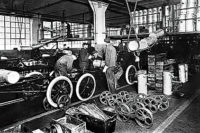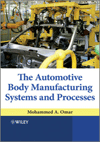Assembly Then & Now: The Man Behind the Moving Assembly Line
This year marks the 100th anniversary of Ford Motor Co. and the 90th anniversary of the moving assembly line. Whenever textbooks or TV documentaries discuss mass production, they invariably mention Henry Ford. In reality, much of the credit should go to another man who worked in Ford’s shadow for many years. The architect of the modern assembly line was Charles Sorensen. His experiments changed the face of manufacturing. Sorensen’s revolutionary idea of moving a vehicle past various workstations, with one worker performing a specific assembly task, transformed the fledgling auto industry and helped Ford dominate the marketplace for many years.
Sorensen (1881-1968) served as Ford’s production chief for 40 years. During that time, he was responsible for numerous innovations that dramatically improved productivity and efficiency. Sorensen masterminded the automated production processes and equipment used in Ford’s three most famous factories: Highland Park, River Rouge and Willow Run.
Highland Park was Ford’s showcase assembly line from 1910 to 1927 when it produced millions of Model T’s. River Rouge became the epicenter of Ford manufacturing in the early 1930s and is currently being transformed into an environmentally sensitive facility. Willow Run was considered a wonder of the world in the mid-1940s when it cranked out one B-24 bomber every hour.
Ford nicknamed Sorensen "Cast-Iron Charlie." Another top executive in the company claimed that Sorensen was "the plaster that held the plant together."
Sorensen emigrated from Denmark to the United States with his parents when he was four years old. His first job was at a stove manufacturer in Buffalo, NY, where he worked in the foundry. After stints in Iowa and Wisconsin, Sorensen made his way to Detroit, where Henry Ford hired him as a pattern maker in 1905. He made wooden models of experimental new parts.
Sorensen worked his way up to production chief in a career that lasted until 1944. Along the way, he developed a wide variety of new manufacturing methods, assembly lines, conveyors and automated equipment that made Ford the world leader in mass production. However, his outspoken boss often took credit for "inventing" that manufacturing system.
"Henry Ford is generally regarded as the father of mass production," Sorensen wrote in his autobiography, My Forty Years With Ford, which was published in 1956. "He was not. He was the sponsor of it.
"Henry Ford had no ideas on mass production. In later years, he was glorified as the originator of the mass production idea. Far from it; he just grew into it, like the rest of us. The essential tools and the final assembly line with its many integrated feeders resulted from an organization, which was continually experimenting and improvising to get better production.
"Mr. Ford had nothing to do with originating, planning and carrying out the assembly line," Sorensen recalled in his book. "He encouraged the work. His vision to try unorthodox methods was an example to us.
"Another misconception is that the final assembly line originated in our Highland Park plant in the summer of 1913. It was born then, but it was conceived in July 1908 at the Piquette Avenue plant, and not with the Model T but during the last months of Model N production."
In his reminiscences, Sorensen claimed that he and some associates laid out a crude chassis assembly line 5 years before the technique was used in actual production. "I had [Charles] Lewis arrange the materials on the floor so that what was needed at the start of assembly would be at that end of the building and the other parts would be along the line as we moved the chassis along," recalled Sorensen. "We spent every Sunday during July planning this. Then one Sunday morning, after the stock was laid out in this fashion, Lewis and I and a couple of helpers put together the first car that was ever built on a moving line. We did this simply by putting the frame on skis, hitching a towrope to the front end and pulling the frame along until axles and wheels were put on."
However, Sorensen’s boss rejected the idea and it was buried in the rush to build the state-of-the-art Highland Park, MI, plant, which opened in 1910. But, Sorensen gradually continued to fine-tune his radical idea. Finally, management consented to more extensive experiments when they were faced with the daunting task of assembling more and more copies of the popular Model T, which debuted in 1908.
Ford and his managers were searching for new ways to increase production speed to keep up with consumer demand. They decided that the best way to achieve higher production volume was to change the way assemblers worked.
On April 1, 1913, the first moving assembly line for a large-scale manufacturing application began to operate. It was used to produce flywheel magnetos.
The magneto coil was a key part of the Model T’s revolutionary ignition system. Instead of using dry batteries, as commonly used at the time, the vehicle featured a magneto that produced sparks for the cylinders, which made it much easier to start the engine. It consisted of a heavy flywheel with copper coils and 16 V-shaped permanent magnets bolted on its front side.
Traditionally, operators stood at individual workbenches and assembled an entire flywheel magneto. One person could build approximately 35 units in a 9-hour shift, or one every 20 minutes. However, by dividing the job into 29 separate tasks performed by 29 operators standing side by side, Sorensen and his team of engineers shaved 7 minutes off each final assembly. The operators were strategically placed along a waist-high row of flywheels that rested on smooth, sliding surfaces on a pipe frame.
The assemblers were instructed by their supervisor to place one particular part in the assembly and then push the flywheel down the row to the next worker, who was located 18 to 36 inches away. Parts such as magnets, supports, clamps, nuts and bolts were located in large bins placed under the assembly line. Assemblers repeated the same process, over and over.
But, everyone did not adapt to the new system. Some workers dragged their heels while others worked too fast. Sorensen solved the problem by setting the pace of production. He moved the magnetos down the assembly line with a chain and experimented with various speeds.
At first, the chain moved 5 fpm, which proved to be much too fast. Then 18 inches per minute was tried, but it was deemed too slow. Eventually, the assembly line moved 44 inches per minute.
By raising the height of the assembly line, moving the magnetos with a continuous chain and lowering the number of operators to 14, Sorensen and his engineering team achieved an output of 1,335 flywheel magnetos, which translated into 5 minutes per magneto vs. 20 minutes with the static assembly process.
The magneto assembly line demonstrated the basic principles behind continuous flow mass production, which quickly became known as Fordism: "Keep the work at the least waist high, so a man doesn’t have to stoop over; make the job simple, break it up into as many small operations as possible and have each man do only one, two or at the most three operations; arrange so the work will come to each man so that he shall not have to take more than one step either way, either to secure his work or release it; keep the line moving as fast as possible."
The dramatic productivity improvements achieved on the magneto assembly line encouraged Sorensen to experiment in other parts of the plant, such as the engine, transmission and rear axle assembly departments. In each case, production times plummeted. For instance, by using a moving line, engine assembly time was slashed from 594 minutes to 226 minutes. Finally, Sorensen tackled the chassis assembly line, which he described as "the most spectacular one."
Before the advent of the moving line, the process of assembling a Model T chassis was very laborious. Workers hauled a bare frame up on two wooden sawhorses and attached a pair of axles and springs. Then, they flipped the frame over and attached four wheels. Gangs of workers moved from workstation to workstation performing a specific task or series of tasks.
All parts and components were hand delivered to each chassis assembly workstation. The process required 500 assemblers and 100 "pushers and shovers" who moved material back and forth. These "part fetchers" were often slow and unreliable, so managers constantly worried about the timely delivery of fasteners and other key parts.
"The idea occurred to me that assembly would be easier, simpler and faster if we moved the chassis along, beginning at one end of the plant with a frame and adding the axles and the wheels; then moving past the stockroom, instead of moving the stockroom to the chassis," recalled Sorensen.
Early assembly line attempts involved pushing each chassis along by hand from one workstation to the next. The rear wheels were supported in a dolly that was guided along a track embedded in the floor.
In August 1913, Sorensen created a crude assembly line in which the chassis was pulled 250 feet by rope and a hand-cranked windlass. As the chassis moved, six assemblers walked along, attaching parts that they grabbed from supply stations along the way. Parts and components were fed to the assembly line via an elaborate system of gravity chutes. Assembly time per chassis dropped from more than 12 hours to less than 6 hours.
Over a 4-month period, Sorensen and his assistant, Clarence Avery, experimented with the line and made numerous changes in speed, workstation positions and the number of assemblers. They tried several different diameters of rope attached to more than 10 chassis at a time. But, each rope snapped under the strain, so they turned to chain. The height of the assembly line was also raised and lowered numerous times.
"This called for patient timing and rearrangement until the flow of parts and the speed and intervals along the assembly line meshed into a perfectly synchronized operation," said Sorensen.
By early October, production time was cut to less than 3 hours by using a 150-foot assembly line and 140 assemblers. Sorensen lengthened the assembly line to 300 feet using 177 operators and slashed production time to 2.3 hours by early December.
On Jan. 14, 1914, the assembly line became power-driven when Sorensen added an "endless chain" powered by a motor. During the next few months, the engineers refined the continuous assembly line. For instance, it was raised 26 inches off the floor so assemblers would not have to bend over too far. By early April, chassis assembly time dropped to 1.5 hours. Eventually, three parallel assembly lines were producing more than 1,200 Model T chassis per 8-hour shift.
The chassis assembly lines were located on the ground floor of the four-story Highland Park factory. The assembly process was divided into 45 separate operations. While moving at a speed of 6 fpm, each vehicle passed under overhead platforms, conveyors and gravity chutes that supplied gasoline tanks, motors, dashboards, wheels and radiators from upper floors of the factory. At the end of the line, each chassis was inspected, filled with fluids and then driven under its own power—the driver sat on the gas tank—to a body chute that was located outdoors, where assemblers bolted the body and seats to the chassis.
Sorensen also developed chain-driven assembly lines for mass producing dashboards, bodies and upholstery. Because of the moving assembly line, Model T production skyrocketed from 13,840 cars in 1909 to 230,788 units in 1914 to 585,388 units in 1916. At the same time, retail price dropped from $950 in 1909 to $490 in 1914 to $360 in 1916.
The millionth Model T was completed on Dec. 10, 1915. Five million had been completed on May 28, 1921. And by June 4, 1924, 10 million Model T’s had been assembled.
"Within a short time, Ford was building 2 million automobiles each year," says Arlie Hall, Ph.D., a former professor at the Center for Robotics and Manufacturing Systems at the University of Kentucky (Lexington, KY). "These amazing achievements wouldn’t have been possible without the aid of Charles Sorensen’s idea that moving the chassis along a route to materials and tools through the plant would be more efficient."
"The introduction of the moving assembly line presaged the auto industry’s future, for with it came the realization that almost all movement through the factory could be mechanized and thus closely controlled by management," claims Lindy Biggs, a history professor at Auburn University (Auburn, AL) and the author of The Rational Factory (Johns Hopkins University Press).
With the assembly line, production figures became consistently predictable. "To Ford and his engineers, the beauty of the moving assembly line was the assurance of steady, nonstop work; the line kept moving and the workers had to work along with it," explains Biggs. "The moving assembly line gave the production department the capability to say how many cars it can build in a time, for it knows how fast the conveyor chain moves, and how many chassis can be put on the track."
"In ‘moving the work to the men,’ the fundamental tenet of the assembly line, the Ford engineers found a method to speed up the slow men and slow down the fast men," adds David Hounshell, a history professor at Carnegie Mellon University (Pittsburgh) and author of From the American System to Mass Production (Johns Hopkins University Press). "With the installation of the assembly line and the extension of its dynamism to all phases of factory operations, the Ford production engineers wrought true mass production."
Ford Motor Co. was completely open about its new production methods and encouraged people to tour its facilities. Trade magazines such as American Machinist, Engineering, Iron Age and Machinery published extensive articles on the moving assembly lines and innovative material handling practices. In addition, Horace Arnold and Fay Faurote wrote a popular book entitled Ford Methods and the Ford Shops that detailed the entire Model T manufacturing process.
"As a consequence of Ford’s openness, Ford production technology diffused rapidly throughout American manufacturing," says Hounshell. Other automakers, such as Buick, Hudson, Packard and Studebaker, quickly adopted the moving assembly line in their factories.
"Manufacturers of other products also tried the assembly line," notes Hounshell. "Within a decade, many household appliances, such as vacuum sweepers and radios, were assembled on a conveyor system. The Ford Motor Co. educated the American technical community in the ways of mass production."
However, Sorensen and his cohorts were sometimes chastised and ridiculed. For instance, some critics claimed that the mass production system they created took skill out of work and dehumanized the factory. "By putting higher skill into planning, management and tool building it is possible for skill to be enjoyed by the many who are not skilled," argued Sorensen. "There are not enough men on earth with skill in their hands to produce all the goods that the world needs. When skill is built into machines and material flows continuously into those machines, two things are done at once.
"It has been made possible for unskilled workers to earn higher wages, and the products they turn out satisfy human wants that otherwise wouldn’t be satisfied at all," added Sorensen. "Under this system man is not a slave to the machine, he is a slave without it. Machines do not eliminate jobs; they only make them easier—and create new ones."
In his autobiography, Sorensen claimed that his contribution to mass production was "the practice of moving the work from one worker to another until it became a complete unit, then arranging the flow of these units at the right time and the right place to a moving final assembly line from which came a finished product. Regardless of earlier uses of some of these principles, the direct line of succession of mass production and its intensification into automation stems directly from what we worked out at Ford Motor Co. between 1908 and 1913."
Sorensen was knighted by Denmark’s King Christian in 1937 for his accomplishments. After he retired from Ford in 1944, Sorensen became chairman of Willys-Overland Co. and transformed the World War II Jeep into a civilian version known as the Jeepster, a forerunner of today’s sport utility vehicle. Two years ago, Sorensen was elected to the Automotive Hall of Fame (Dearborn, MI) for his contributions to the industry.
Although the Highland Park and Piquette Avenue plants were abandoned by Ford long ago, the buildings still stand in Detroit. Both structures have been designated National Historic Landmarks. The Highland Park plant is in derelict condition, but the Piquette Avenue plant is in the process of being converted into the Model T Automotive Heritage Complex.
Looking for a reprint of this article?
From high-res PDFs to custom plaques, order your copy today!









